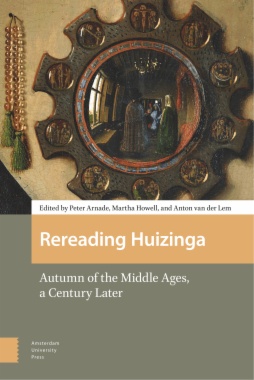Rereading Huizinga: Autumn of the Middle Ages, a Century Later explores the legacy and historiographical impact of Johan Huizinga’s 1919 masterwork a century after its publication. Often considered one of the most successful books in medieval European history, its reception has varied over the last hundred years, popular with non-academic readers, and appraised more critically by fellow historians and those more generally in the field of medieval studies. There is broad consensus, however, about the work’s absolute centrality, and the authors of this volume assess the Autumn of the Middle Ages reception, afterlife, and continued vitality.
- Cover
- Table of Contents
- Acknowledgements
- Introduction
- Peter Arnade and Martha Howell
- Part I: Huizinga and the Late Medieval North
- 1. Huizinga’s Autumn
- The Burgundian Court at Play
- 2. Wrestling with the Angel
- Huizinga, Herfsttij, and Religion
- 3. Huizinga’s Silence
- Urban Culture and Herfsttij
- Jan Dumolyn and Élodie Lecuppre-Desjardin
- 4. The Forms behind the Vormen
- Huizinga, New Cultural History, and the Culture of Commerce
- 5. Yet Another Failed State?
- The Huizinga-Pirenne Controversy on the Burgundian State Reconsidered
- Part II: Art, Literature and Sources in
Autumn of the Middle Ages
- 6. Art History and Huizinga’s Autumn of the Middle Ages
- 7. Did Germany Have a Medieval Herbstzeit?
- 8. The Making of The Autumn of the Middle Ages I
- Narrative Sources and Their Treatment in Huizinga’s Herfsttij
- 9. The Making of The Autumn of the Middle Ages II
- The Eagle and His Pigeonholes: How Huizinga Organized His Sources
- Part III: Legacies: Huizinga and Historiography
- 10. Harvest of Death
- Johan Huizinga’s Critique of Medievalism
- 11. Huizinga, Theorist of Lateness?
- 12. Huizinga: Anthropologist Avant la Lettre?
- 13. A Late and Ambivalent Recognition
- (The Autumn of) Johan Huizinga and the French Historians of the nouvelle histoire
- Epilogue
- Bibliography
- Index of Names
- List of Illustrations
- Illustration 7.1 Anonymous Parisian goldsmith, Goldenes Rössl (Little Golden Horse), c. 1405, gold, silver, enamel, precious stones. Altötting, Schatzkammer der Heiligen Kapelle
- Illustration 7.2 Master of the Amsterdam Cabinet [Housebook Master], A Pair of Lovers, c. 1480-1485
- Illustration 7.3 Housebook Master, Standing Lovers, c. 1485, silverpoint drawing
- Illustration 7.4 Albrecht Dürer, Wedding of Maximilian of Habsburg to Mary of Burgundy (Small Triumphal Chariot), c. 1516-1518, woodcut
- Illustration 7.5 Hans Burgkmair, Theuerdank as Champion of Fortune, woodcut from Theuerdank (Augsburg: Johann Schönsperger, 1517), ch. 118
- Illustration 7.6 Hans Burgkmair, Equestrian Portrait of Emperor Maximilian I, 1508, woodcut
- Illustration 9.1 Huizinga in his study as a professor in Groningen
- Illustration 9.2 Huizinga’s study in Leiden, Van Slingelandtlaan 4, 1935 or later
- Illustration 9.3 List of books in Huizinga’s handwriting of books returned to the Royal Library in The Hague and the University Library of Leiden
- Illustration 9.4 Inserted page in Huizinga’s copy of the Annales Egmundani, with his remarks
- Illustration 9.5 Notes from La Marche and Molinet in the envelope ‘Entremets’
- Illustration 9.6 The only left page of the manuscript of Herfsttij der Middeleeuwen. One-quarter of the pages is missing because of reuse of the reverse
- Illustration 9.7 Huizinga as a student in his study in his elderly home
- Illustration 9.8 Balzac’s Lettres à l’étrangere (Paris: Calmann-Lévy, 1899), with the title written by Huizinga himself

